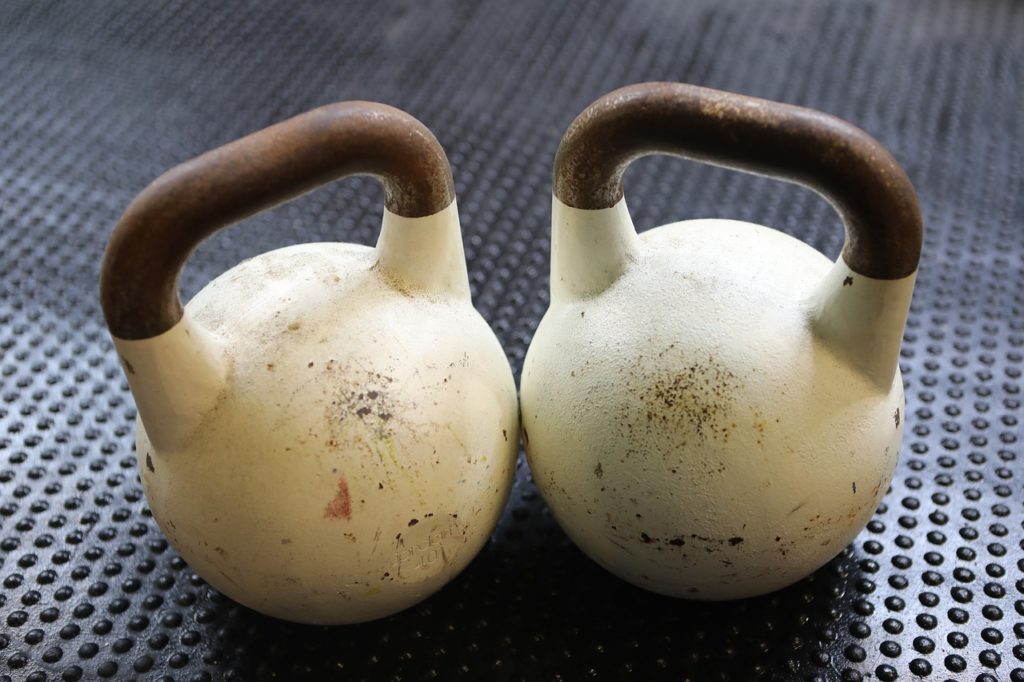I may receive a commission for purchases made through product links on this page, but I always stand by my opinions and endorsements!
Kettlebells are often made of metal and are available in various coatings, such as a powder coating or vinyl coating.
In this article, you’ll be able to decide which kettlebells are best for you and how to properly protect them from rust after purchasing them.

Why do kettlebells become rusty?
Rust on kettlebells can be attributed to a variety of reasons, but it’s mainly due to the material (metals) they’re made of.
Metals such as iron and nickel begin to rust when they become wet or when they are stored in humid areas. Moisture corrodes these metals which causes rust on the surface.
A rusty kettlebell can have a weakened structure and makes for a messy and potentially unsafe experience.
Do cast iron kettlebells rust?
Cast iron kettlebells are the most common kettlebells found in gyms, and are some of the most popular kettlebells to purchase online.
Due to cast iron kettlebells being barebones and exposed metal, they are the most susceptible to rust when not taken care of properly.
Do vinyl kettlebells rust?
Vinyl kettlebells are an excellent alternative to traditional cast iron kettlebells. Vinyl kettlebells are made the same way as cast iron kettlebells, except they are finished off with a vinyl coating covering most of the metal.
While vinyl kettlebells are marketed as a safer option for the surfaces you are using them on, unfortunately, they are also susceptible to rust if not taken care of properly.
How to prevent kettlebells from becoming rusty
Exercise equipment can become quite expensive when starting and kettlebells are no exception.
However, a set of kettlebells can last an extremely long time and are easily worth the purchase price if taken care of properly.
The main defence against rust on your kettlebells is keeping them dry as much as possible.
When completing a workout simply make sure to wipe down the kettlebell to ensure that the surface is free from any sweat or water.
When storing kettlebells you should be sure to keep them in a cool, dry place. In a warm and humid environment, kettlebells can collect moisture on the surface and over time become covered in rust.
How to remove rust from kettlebells
Kettlebells are often made of iron or metals containing iron.
When a kettlebell starts to rust on the surface, it can be salvaged before the rust grows and penetrates deeper into its structure.
There are many ways to get rid of the rust on the surface of your kettlebell, but the most popular and easiest way is to sand the rust off the surface.
Sanding the rust off the surface is as simple as using a lower grit sandpaper and some elbow grease, or if you have an orbital sander, it can be done at a more efficient pace.
Either way, removing the rust at the earliest point will ensure the kettlebell maintains a strong structure for many years.
Once the rust is removed, you should paint the kettlebell with enamel to help prevent further rusting on the surface for a longer period of time.
Should you use rusty kettlebells?
While you can technically use rusty kettlebells, it is not recommended without trying to solve the issue first.
Rust on the surface of the kettlebell will most definitely stain any clothing it comes into contact with and will get on your hands as you exercise, meaning anything you touch afterward will become covered in rust.
Rusty kettlebells can also cause seriously irritated skin for long periods of time that is otherwise preventable by ridding the kettlebell of rust before use.
3 examples of rust-resistant kettlebells
Beyond the standard bare cast iron kettlebells, there are multiple variations that provide rust-resistant protection.
It’s recommended by the majority of kettlebell users to get a kettlebell with at least an enamel painted coating, with vinyl being the next recommended, but powder-coated being what most prefer.
Below are a few of the most recommended kettlebells on Amazon broken down by each category so that you can decide which rust-resistant kettlebell option is best for you.
Enamel Cast Iron Kettlebells
Amazon Basics provides entry-level enamel-coated cast iron kettlebells that range from ten pounds all the way up to fifty pounds.
These particular kettlebells have an outstanding rating on over 11,000 reviews and are recommended as the minimum entry-level kettlebells that offer rust resistance, thanks to the enamel finish.
Check price and read more reviews of Amazon Basics Cast Iron Kettlebell on Amazon.
Vinyl Kettlebells
Yes4All is another respected brand for kettlebells on Amazon amassing a near-perfect rating with over 12,000 reviews. These vinyl kettlebells are the next level in rust resistance as they are coated up to the handle in vinyl.
Vinyl Kettlebells are recommended by most reviewers for protecting indoor surfaces and the vinyl offers scratch resistance on hardwood floors. Yes4All vinyl kettlebells come in five-pound increments starting at five pounds up to fifty pounds.
Check price and read more reviews of Yes4All Vinyl Kettlebell on Amazon.
Powder Coated Kettlebells
Yes4All also makes the highest-rated powder-coated kettlebells on Amazon. These powder-coated kettlebells have a flawless rating on over 5,000 reviews with almost all reviewers touting how durable and long-lasting the powder coating is.
These kettlebells are often regarded as some of the most rust-resistant available ranging from five pounds increasing in five-pound increments up to fifty pounds.
Check price and read more reviews of Yes4All Power Coated Kettlebell on Amazon.
Sources
I’ve been in the fitness and strength training industry for nearly a decade. In that time, I’ve gained 30 pounds of muscle, written hundreds of articles, and reviewed dozens of fitness supplements. As for my educational background, I’m a currently studying for my Active IQ Level 3 Diploma in Personal Training.




